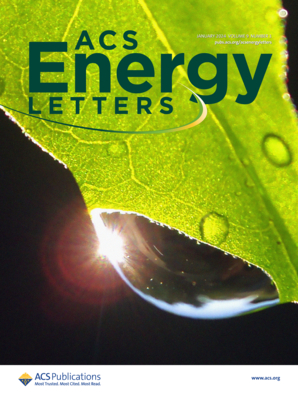Imaging Phase Boundary Kinetics in Lithium Titanate Using Operando Electron Energy-Loss Spectroscopy
IF 19.3
1区 材料科学
Q1 CHEMISTRY, PHYSICAL
引用次数: 0
Abstract
Lithium titanate accommodates and releases lithium ions through phase separation. The dynamics of the phase boundary movement are critical to battery performance, particularly for maximizing the charge/discharge rates. However, details of this boundary movement remain unclear. Here, we visualize the phase boundary movement by tracking the Li distribution using operando scanning transmission electron microscopy coupled with electron energy-loss spectroscopy. For Li insertion, the rate constants of the phase boundary movement were 3.6 ± 0.9 × 10–13 cm2/s at 30 °C and 3.2 ± 0.3 × 10–11 cm2/s at 105 °C, whereas for Li extraction they were 4.0 ± 0.7 × 10–11 cm2/s at 30 °C and 1.9 ± 0.6 × 10–9 cm2/s at 105 °C. The activation energies for Li-ion diffusion were 0.49 and 0.59 eV for Li4Ti5O12 and Li7Ti5O12, respectively. The relatively low activation energy of 0.49 eV is the reason lithium titanate exhibits a high-rate discharge performance.

求助全文
约1分钟内获得全文
求助全文
来源期刊

ACS Energy Letters
Energy-Renewable Energy, Sustainability and the Environment
CiteScore
31.20
自引率
5.00%
发文量
469
审稿时长
1 months
期刊介绍:
ACS Energy Letters is a monthly journal that publishes papers reporting new scientific advances in energy research. The journal focuses on topics that are of interest to scientists working in the fundamental and applied sciences. Rapid publication is a central criterion for acceptance, and the journal is known for its quick publication times, with an average of 4-6 weeks from submission to web publication in As Soon As Publishable format.
ACS Energy Letters is ranked as the number one journal in the Web of Science Electrochemistry category. It also ranks within the top 10 journals for Physical Chemistry, Energy & Fuels, and Nanoscience & Nanotechnology.
The journal offers several types of articles, including Letters, Energy Express, Perspectives, Reviews, Editorials, Viewpoints and Energy Focus. Additionally, authors have the option to submit videos that summarize or support the information presented in a Perspective or Review article, which can be highlighted on the journal's website. ACS Energy Letters is abstracted and indexed in Chemical Abstracts Service/SciFinder, EBSCO-summon, PubMed, Web of Science, Scopus and Portico.
 求助内容:
求助内容: 应助结果提醒方式:
应助结果提醒方式:


